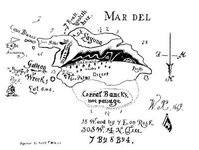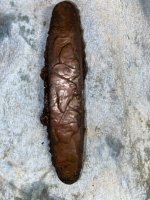I just came to a realization. The pit may very well have been dug nearly 500 years ago.
A possible scenario.
Spanish explorers were out exploring islands and came upon a depression on a remote island. Dreaming of stealing riches from native inhabitants and their untold gold riches they stumbled upon a native and began to torture him and demand to know what is in the pit.
What they didnt know was several years before a shipwreck survivor had been stranded on the island after drifting in on debris. He spent many days carving on rocks and leaving signs of his presence. When the Spanish explorers found some scratches on the rocks they knew something was there. There interpreter was busy getting a confession out of the Native, there was 2,000,000 English pounds buried there, plus a Klingon Bird of Prey.
So after many days of digging they get down to the porous rock and find that water is starting to come in on heavy surge days. No problem they say, Lets build a retaining wall and pack it with coconut fibers and it will slow down the water so that our pumps can keep up. Weeks go by with no progress of excavation the water keeps running in. So they say screw it lets dump our trash and hide our presence, fill it back in and add planks from the retaining wall to keep the dirt from recompacting and we will be back to dig it up. They leave a block in the tree and take off back to Spain and shortly there after sink in the North Atlantic with all souls perishing.
This is actually quite a likely scenario if you take the history and intrigue that the area seems to generate.
What are the thoughts on this?
Of course there should be more evidence of prior excavations but lets just say they where really tidy and picked up anything that might have given up the location. We may just be watching history running in a continuous loop with only the technology and names changed. Just digging a dream even if there is nothing there?
A possible scenario.
Spanish explorers were out exploring islands and came upon a depression on a remote island. Dreaming of stealing riches from native inhabitants and their untold gold riches they stumbled upon a native and began to torture him and demand to know what is in the pit.
What they didnt know was several years before a shipwreck survivor had been stranded on the island after drifting in on debris. He spent many days carving on rocks and leaving signs of his presence. When the Spanish explorers found some scratches on the rocks they knew something was there. There interpreter was busy getting a confession out of the Native, there was 2,000,000 English pounds buried there, plus a Klingon Bird of Prey.

So after many days of digging they get down to the porous rock and find that water is starting to come in on heavy surge days. No problem they say, Lets build a retaining wall and pack it with coconut fibers and it will slow down the water so that our pumps can keep up. Weeks go by with no progress of excavation the water keeps running in. So they say screw it lets dump our trash and hide our presence, fill it back in and add planks from the retaining wall to keep the dirt from recompacting and we will be back to dig it up. They leave a block in the tree and take off back to Spain and shortly there after sink in the North Atlantic with all souls perishing.
This is actually quite a likely scenario if you take the history and intrigue that the area seems to generate.
What are the thoughts on this?
Of course there should be more evidence of prior excavations but lets just say they where really tidy and picked up anything that might have given up the location. We may just be watching history running in a continuous loop with only the technology and names changed. Just digging a dream even if there is nothing there?



 ? I believe that you have judged before any has looked at what I offer.
? I believe that you have judged before any has looked at what I offer.


